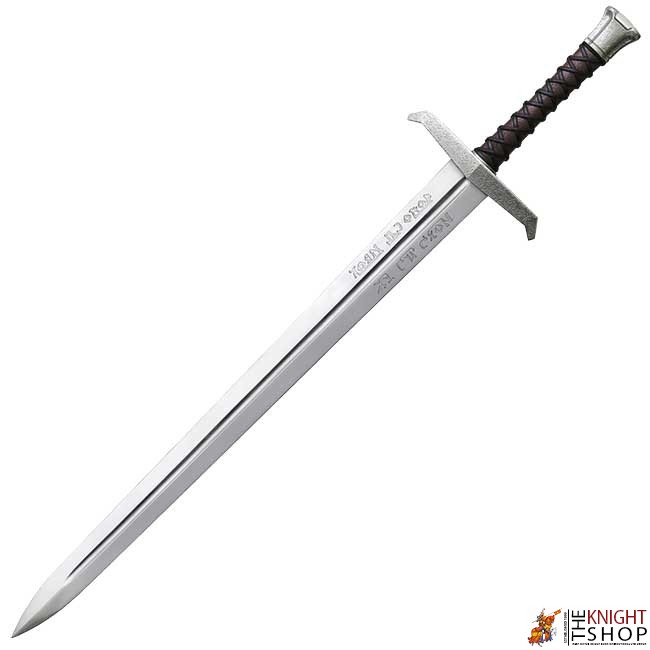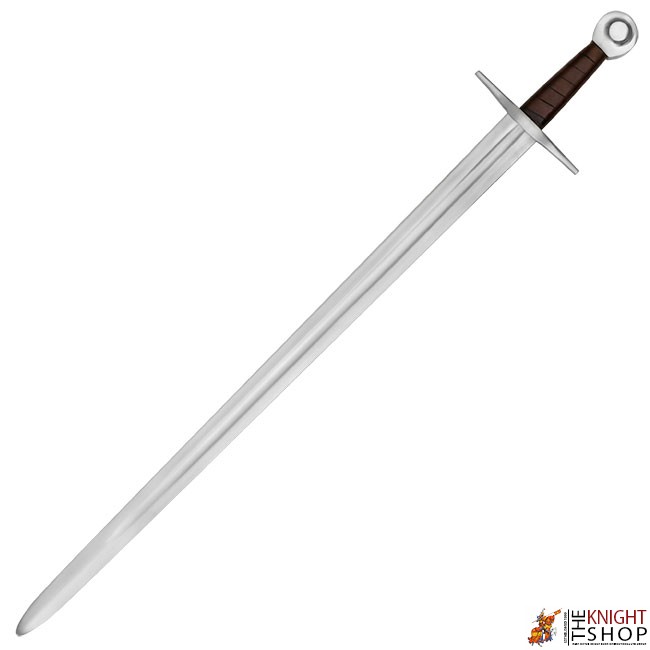What makes a sword great is sometimes the story behind it. Whether the story is a legend passed down or recorded history, the story starts with the man who uses the sword. We have selected a few of our swords that have all been wielded by what we consider ‘legendary men’.
Excalibur
 King Arthur – Excalibur
King Arthur – ExcaliburWe all know the story of King Arthur and his knights of the round table. Literature tells of a great warrior who defended Britain against the Saxons during the 5th and 6th Century, along with his fellowship of knights but there is little physical evidence to support these stories. Depicted by Nennius of Wales in his work History of the Britons, Arthur wins many battles throughout history with the legendary sword, Excalibur. Excalibur is said to be the source of Arthur’s power but once again there are contradicting tales of how Arthur came to obtain Excalibur.
As one of the most renowned swords in history, some regard Excalibur to be the same sword as the Sword in the Stone but in most versions they are seen as two separate weapons. In the tale of the Sword in the Stone, Excalibur can only be pulled free from the stone by the ‘true king’, this is how Arthur shows his is the true, rightful king. While the early descriptions say Excalibur is not magical, later stories tell of ‘The Lady of the Lake’ bestowing Excalibur to King Arthur after his original sword was damaged in battle. We will never know the exact truth behind the tales of King Arthur but what we do know is the legend will forever keep people intrigued.
William Marshall Sword

Known as ‘the best knight that ever lived’, William Marshal the 1st Earl of Pembroke, was an Anglo-Norman solider and statesman who served five English Kings: Henry II, his son, Richard I, King John and John’s son. Knighted in 1166, he spent his younger years as a successful tournament competitor until marrying Isabel de Clare in 1189, making him Earl of Pembroke.
In 1216, he was appointed as regent to a nine year old Henry II son and served the young king until his death in 1219. On the young king’s deathbed, he asked Marshal to take up his vow to join the crusade to the Holy land. With King Henry II’s blessing he ventured to Jerusalem for the next two years. On his return, he re-joined Henry II’s court as a Captain. After Richard 1st defeated Henry II in battle, Marshal was surprisingly welcomed by his foe in court. William would serve Richard the Lionheart until his death. In 1199, when King John succeeded the throne from his brother Richard, William was in full support of the new King, arguing his claim to the throne.
William was one of the few English Earls to remain loyal to the king through the First Barons’ War. It was William whom King John trusted on his deathbed to make sure John’s nine-year-old son Henry would get the throne. Upon the King’s death, William Marshal was appointed as the protector of King John’s son. William realised his health was failing and later died in 1219 at Caversham. Williams’s loyalty and military accomplishments over the years led to the trust and admiration of each King he would serve, creating a successful life and career as a knight and loyal servant to the crown.
Odin Viking Sword

Odin is possibly one of the most well-known characters in Norse mythology. As the ‘father of all the Gods’, he is associated with aspects of life such as war, wisdom, sovereignty, poetry, magic and death. The Norse saw Odin as the vital force that held the world together, nicknaming him the ‘Allfather’ and playing a central role in the creation and destruction of the world.
Before the world existed, he and his two younger brothers, Vili and Ve, killed the primal frost giant Ymir. They used Ymir’s bones, blood, and flesh to form the Universe. Odin arranged the heavens for the gods, the middle world for humans and dwarfs, and the underworld for the dead. He then created the first man and woman from an ash tree and an elm tree. The worship of Odin flourishes across Northern Europe during the age of the Vikings in 700 to 800 AD.
Our Odin Viking Sword is based on an excavated find from Dyback in Sweden and now on display in the Historiska Museum, Stockholm. It is one of the finest Viking era swords ever found in Scandinavia. We named this sword after the god Odin because of its majesty compared to other Viking Swords but in truth, Odin did not carry a sword as his weapon. His weapon was a spear called Gungnir, meaning ‘swaying one’ in Old Norse. This was no ordinary spear as Gungnir was forged by dwarves, the most skilled smiths in the Universe. A perfect weapon for a God.
Grand Master of Templars Sword

The Templars or as they were commonly known, the Knights Templar, were an organisation of devout religious men who carried out military operations from 1118 to 1314. Though its original purpose was to protect pilgrims from danger in the Holy Land, the Knights Templar progressively expanded its duties. They became defenders of the Crusader states in the Holy Land and were known as brave, highly skilled warriors.
The leader of the order was named ‘The Grand Master’. The Grand Master was elected and presided from Jerusalem. Once elected, the position would be for life unless killed during duty but this was not always the case as some Grand Masters did resign. The very first Grand Master was Hugues de Payens, followed by Everard des Barres after his death. After this, 21 Grand Masters followed until the last (23rd) Grand Master, Jacques de Molay who was burned at the stake in Paris in 1314 by order of King Philip IV. Some say that the King framed Jacques de Molay and the Knights Templar, accusing them of crimes they did not commit, for the reason he owed a large amount of debt to the knights. The order of the Knights Templar was eventually dissolved by the Pope in 1312.
Gustavus Adolphus II Rapier

Gustavus Adolphus II might not be a name most recognise but it’s one that is synonymous with the forming of a great nation. Gustavus Adolphus, also known as ‘The Golden King’ and ‘The Lion of the North’, was the King of Sweden between 1611 to 1632. Placed on the throne at a mere 16 years old, Gustavus Adolphus was famed for his victories in battle and founding Sweden as a great power within Europe.
During his short reign, he contested three wars against the Russians, the Danes and the Polish – with each win, Sweden grew in territory, trade and economy. Gustavus Adolphus was famed for leading the charge on the frontline, and he did so with his weapon of choice, his Rapier. Our Gustavus Adolphus II Rapier is modeled after the very one Gustavus Adolphus used on the battlefield.
His final battle came in 1632 at the battle of Lutzen in Germany. Gustavus’s forces came to the aid of a Protestant Germany, against the Catholic armies of the Roman Empire but Gustavus surprise attack was futile as he was paralysed with a gunshot to the back and later one to the temple. His body was found and return to Stockholm to be buried. Gustavus Adolphus day is marked every November 6th in Sweden.
